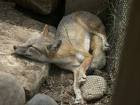October 31 is the festival of Samhain (pronounced Sow-en). It is the end of the yearly cycle, when the earth and her inhabitants enter the cold, dark winter and await the coming of spring. It is the beginning of the Celtic New Year, and one of the most sacred days on the pagan calendar. It is a day for communing with the spirits of our ancestors, asking for aid or advice or simply wishing them well in their journey through the afterlife.
The mundane world knows this day as Halloween, or Hallowe’en, a contraction of All Hallow’s Eve. The holiday begins at sundown and continues through November 2, celebrated in Mexico as the Day of the Dead.
Many of the customs associated with Halloween originate in pagan practices. Lanterns were carved out of gourds or squash and put in windows to light the way for the spirits. This evolved into the Jack O’ Lantern. People dressed in costumes to disguise themselves in hopes of fooling harmful spirits into passing them over when out to make mischief among the living. Children would go door-to-door asking for treats in return for not playing tricks on their neighbors. Sound familiar?
Another custom is to prepare food to be consumed as sustenance for the spirits as they pass by. Some people go so far as to set an extra place at the dinner table for their dearly departed ancestors and friends. Popular foods are apples, cider or ale and bread. In Mexico and other Latin countries, families have picnics at the gravesites of their loved ones, often eating the favorite foods of the dead and leaving offerings of the food behind to be “eaten”.
Traditions holds that on this day the veil between the spirit world and the mundane world is at its thinnest, allowing the spirits free passage between the two. It also allows us to communicate with those who have passed, ask their counsel and hope they will pass on some of the wisdom they accumulated in their own long lives. It is a good night for divination rituals of all kinds. If you have any questions about how the coming year will go for you, now is the time to ask.
I celebrate this day the way most people do: I carve pumpkins, decorate my house with bats, skulls, ghosts and ghouls, and hand out candy to the neighborhood children when they come to the door. On November 1, I make an altar dedicated to the spirits of those I have known who have passed. I often include a remembrance of all those who suffer and die needlessly for their untraditional beliefs, such as all the victims of the Salem Witch Trials.
My altar usually looks like this:
Anubis is represented, because he is the lord of the underworld and this is an important day for him. The Nile River Goddess is also there, opposite him. She represents the ongoing cycle of life, death and rebirth. I decorate the altar with sprigs of rosemary, the herb of remembrance, and marigolds, flowers often associated with the dead. The skulls represent the voices of the dead, and the knowledge they have to bequeath to us.
I prepare a meal, which consists of bread, apple juice (I am teetotaler so the spirits don’t get ale from me.) and an apple. Apples stand for new beginnings and rebirth. For this reason, they are also traditionally eaten on May Day, or Beltane, the holiday directly opposite Samhain on the pagan calendar. I make a spirit candle to let the spirits know there is a friendly stop for them on their journey.
Samhain is one of the oldest holidays we humans celebrate. It allows us to get in touch with our mortality, broadens our minds and inspires us with courage to face a continuing life in an alternate plane of existence. When you think of how many other “lives” we may have, some of the things we think are so important don’t really seem like a such a big deal, after all. As our modern society gets farther and farther away from its roots, the origins of this day, and all the old celebrations, fade into obscurity. I’m doing my part. As long as someone continues to celebrate these old holidays, the old traditions will stay with us. They will never die.
Happy Hallowe’en.
On John Williams
7 years ago













